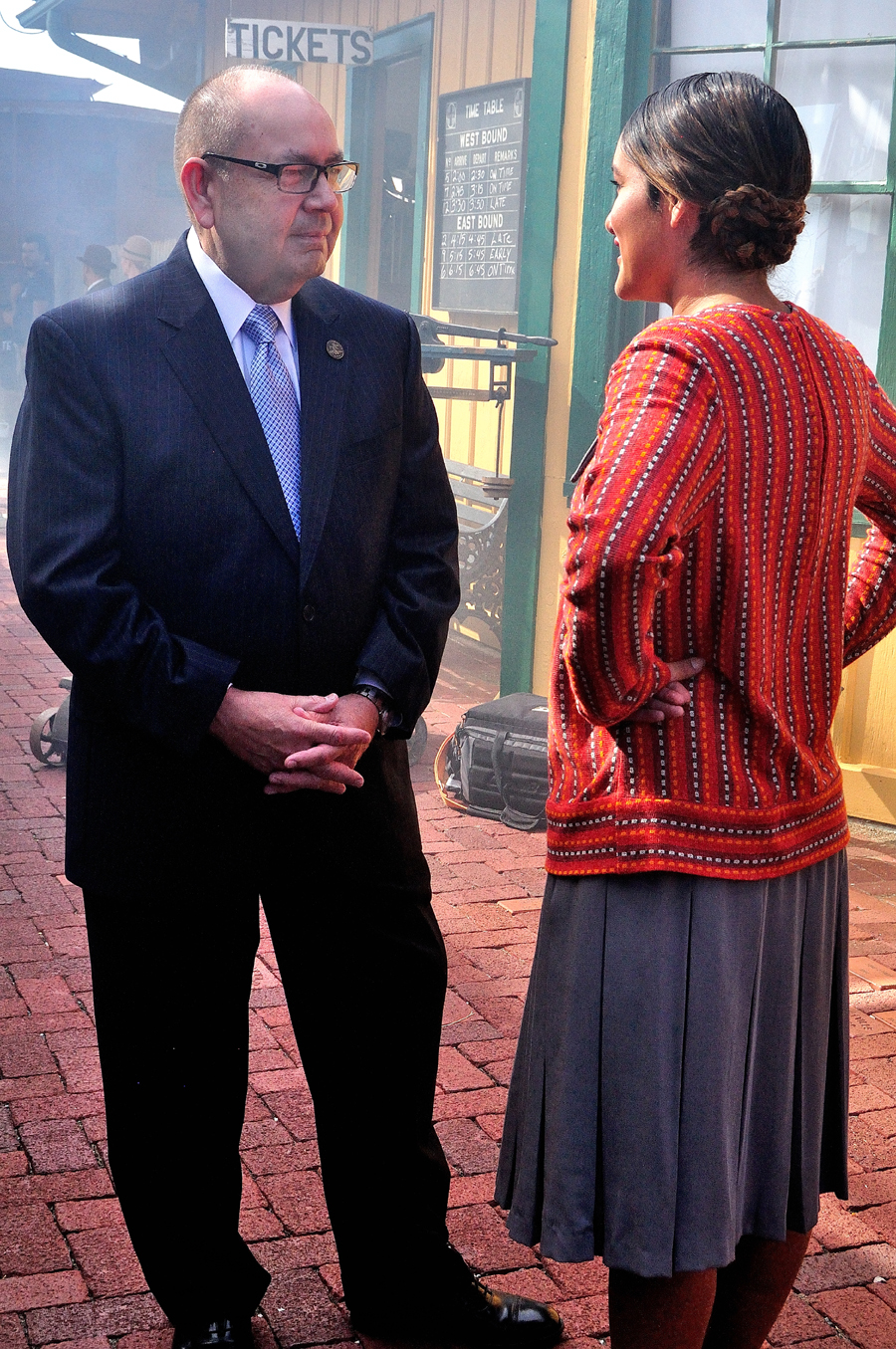‘Te Ata’ Oklahoma filming ends; post production now under way

This article appeared in the November 2014 edition of the Chickasaw Times
GUTHRIE, Okla. – A hypnotic Oklahoma sunset – blazing pastels of pink, purple and red – was showing off just as a “Discover Oklahoma” film crew prepared to interview native Oklahoman Cindy Pickett.
“Why don’t we turn the camera toward that great sunset,” Ms. Pickett inquired. “An Oklahoma sunset; there’s nothing like it,” she observed, using her long, willowy fingers to sweep away a few tears. “There is something about coming home again that makes me very emotional.”
It was late. The camera crew was facing northeast at the Scottish Rite Masonic Temple to interview Ms. Pickett. She had just finished her last scene on the last day of filming of “Te Ata.”
Many entertainment enthusiasts will remember Cindy Pickett for roles in “The Guiding Light” and “St. Elsewhere” on the small screen; as an angst-filled mom in “I Know My First Name is Steven,” and the mother of Matthew Broderick in “Ferris Bueller’s Day Off” on the big screen.
In “Te Ata,” she brings to life Francis Davis, an Oklahoma College for Women (OCW) drama instructor who influenced Te Ata’s life on personal and professional levels.
Ms. Pickett was born in Norman, reared in Sand Springs. But her favorite memories are “on the farm at Loco” a blink-and-you’ll-miss-it hamlet southeast of Duncan halved by state Highway 53. There, her grandparents tilled the earth and tended animals. There, “Cindy Lou” spent many summers falling deeply in love with Oklahoma.
“You know what’s fascinating about it (is) after living in New York and Los Angeles for years; I remember the sounds (on the farm) and the smells of the wind in the grass. I’m just so happy to be here and the film we’re doing is just wonderful.”
IT’S A WRAP
Facebook posts and photos told the story in the wee hours of Oct. 9.
Filming of “Te Ata” had reached its conclusion.
Producer of the film, Paul Sirmons, had also reached a new conclusion about Oklahoma.
While Mr. Sirmons worked as line-producer on “Home Run,” which was filmed in Oklahoma, he was still somewhat skeptical when the Chickasaw Nation approached him wanting to film “Te Ata” entirely in Oklahoma.
“I’m from Florida, so my mental images of the dust bowl and people hopping aboard jalopies are difficult to escape,” Mr. Sirmons said, admitting “The Grapes of Wrath” dominated his thoughts.
When returning to Oklahoma, Mr. Sirmons experienced an epiphany. He was welcomed by rolling hills and beautiful rivers; period mansions with proper furnishings; a Chickasaw Nation Capitol in Tishomingo that looks much the same as it did in 1898, and the clean, cool water of Pennington Creek, where a young Te Ata explored, hiked and meditated.
Even though he was impressed by the natural beauty and historic building in Tishomingo, the true selling point to an all-Oklahoma shoot was the Scottish Rite Masonic Temple in Guthrie, the producer confirmed.
“We could film almost everything here,” he said taking in the stately, overwhelming presence of one of the largest masonic temples in the world.
Beyond the grand architecture and massive columns perfect for scenes set in Washington, rooms complete with period furniture and refined appointments proved ideal for interior shots.
Critically important scenes filmed within the building are virtually endless – Te Ata’s dorm room at OCW; the OCW campus; President Franklin Roosevelt’s office; the U.S. Capitol; offices of the U.S. Senate; a Broadway stage; the American Museum of Natural History and Hayden Planetarium; Pittsburg’s Carnegie Institute of Technology. Even Carnegie Hall was available in Oklahoma, Sirmons discovered.
On a lovely October day, the temple’s spaciousness enveloped extras, executives, producers, historians and actors.
All of them – bone-weary from 12- to 14-hour days for more than a month – were prepared for the film’s conclusion.
“Perhaps Champagne would be an appropriate swan song,” Ms. Pickett pondered aloud as she gracefully moved toward wardrobe to surrender a 1915-era blouse, skirt and high-heeled shoes to don more comfortable haberdashery.
“When I put these heels on about 10 hours ago, they were comfortable,” the actress said smiling.
JUST HANGING OUT
After changing, Ms. Pickett headed back into the temple to join the crew and actors until the very end. She was not ready to leave her native state. She talked about meeting people who had relocated to Guthrie from California. She even inquired about renting a domicile in this central Oklahoma community of approximately 20,000 souls.
She speculated her two adult children probably would not be interested in leaving Los Angeles, but she is because of a special project that almost requires her presence in Oklahoma.
“It’s a screen play inspired by my father,” she explained, her sky-blue eyes misting up again. “And, it reminds me a lot of this film about Te Ata. Everyone needs teachers who inspire; everyone needs advocates to advance and grow in all areas of life. My father was like that and was aware of the people, places and circumstances that made up his life, and the lives of others,” Ms. Pickett said.
Her father, Cecil Pickett, was also involved in acting and theatre. He is most noted as a director and drama instructor at the University of Houston.
Ms. Pickett’s project would be set in late 1930s Oklahoma.